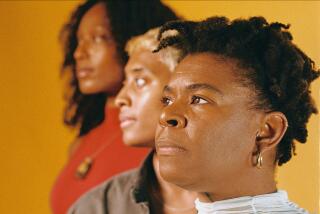Will the last gay bar in Laguna Beach please turn out the lights?
- Share via
The bungalow at Pacific Coast Highway and Cress Street used to be a happy hour beacon in Laguna Beach. Young men holding hands, Will-and-Grace types, the occasional gaggle of curious straights, the random lesbian couple--all would gather on weekends at Woody’s at the Beach, a cottage-y gay bar. By midnight, the party would spread down the block to the venerable Boom Boom Room, with its dancing and drag queens, and to Bounce, a smaller joint across the street.
Sometimes neighbors complained. Sometimes tourists gawked and hollered. But the scene, like the town’s art galleries and surf shops, was part of the area’s character and history. Before Laguna Beach was conjuring images of drama-prone TV teens and oceanfront mansions, it was the city that elected America’s first openly gay mayor. Its incidence of AIDS was, for a time, among the highest per capita in the nation. The Boom Boom Room is where Rock Hudson and Paul Lynde and Bette Midler once partied. Woody’s, under one owner or another, had been gay for two generations.
The block-long promenade between them was like a miniature West Hollywood in the heart of once-conservative Orange County, and locals insisted the town wouldn’t be itself if it went away.
Then the Boom Boom Room was sold to a billionaire with plans to eventually turn the site into a boutique hotel. Within a year, the owners of Woody’s got an offer to cash out. A family-owned Mexican restaurant took over the space. Down went the fence that hid the back patio. In came the highchairs. When the new Avila’s El Ranchito opened last month, leaving the Boom, as it is locally known, to boom alone into an uncertain future on its side of the highway, the block took on the feel of both a beginning and an ending.
And now, though the margaritas at the new place are both popular and delicious, the talk of the town is what will become of the local gay scene. Or, as a quipster at a coffeehouse put it one recent morning: “Will the last gay man in Laguna please turn out the lights?”
Laguna Beach isn’t alone in its evolution. From South Beach to San Francisco, progress and economics are creating similar debates.
Though gay neighborhoods are thriving in some cities--Houston, for example--other, more settled enclaves are changing fast. The Castro district in San Francisco has had to make room for more and more straight families. In West Hollywood, straight college kids have infiltrated gay bars, sometimes by the busload, and one of the biggest concerns is what a city official has termed “heterosexualization.”
Matt Foreman, executive director of the National Gay and Lesbian Task Force, has watched the development with mixed feelings. “The loss of these enclaves does hurt and is something to be deeply concerned about,” he says.
On the other hand, much of the change is being driven by inexorable forces. The Internet, he explains, has made it less important for gays and lesbians to go to special bars and communities to meet each other. And the once-blighted neighborhoods that were settled by gays--often because they felt unwelcome elsewhere--now are so gentrified, in many cases, that younger people can’t afford them.
“Property values go up and straight families move in and gay people move on,” Foreman says, “either because they want to capitalize on their investment or simply can’t afford to live there anymore.”
And underlying it all may be an even bigger factor: the power of acceptance, says UCLA demographer Gary Gates. The post-HIV era and the debate over same-sex marriage, he says, have brought about a major shift in public attitudes and “a fairly big coming-out process.”
As a senior research fellow at UCLA’s Williams Institute on Sexual Orientation Law and Public Policy, Gates published an analysis of recent U.S. Census data. Between 2000 and 2005, he says, the census showed a 30% increase in the number of same-sex couples, and a big part of the reason appears to be that these couples felt freer to report their existence. In some states in the Midwestern heartland, for example, the increase was as much as 81%.
The data, Gates says, paint a more diverse picture than ever before of the nation’s gay and lesbian population--and present a far more diverse map of where they are living. Among other things, the numbers show an apparent out-migration of same-sex couples from gay enclaves such as San Francisco into less expensive suburbs and nearby cities such as San Jose, Oakland and Berkeley.
In Orange County, gay organizations report similar movement: “The gayest town in Orange County is still overwhelmingly Laguna,” says Jon Stordahl, vice chair of the board of directors of the Center Orange County, a gay, lesbian, bisexual and transgender service organization. “But the second-gayest is Aliso Viejo, a new community just over the hill with more entry-level housing.”
Gay night life has changed too, Stordahl says. Though several of the county’s gay-only bars have closed in the last year, they have been supplanted by suburban clubs in Orange, Irvine and Costa Mesa that have reached out to their new market with special nights for gay patrons.
“Success comes at a price,” he says, “and part of that success is that the old institutions that catered to us because we had no place to go--maybe we don’t need so much anymore.”
That’s slim comfort for Fred Karger, who during a recent lunch hour sat in a booth at what used to be Woody’s, eating a chicken quesadilla. No, he is not the last gay man in Laguna--the 2000 census shows only four cities in California with a higher proportion of same-sex households. But he’s worried: “You’re not going to have people moving in if there’s no life here--no gay life.”
Karger is a 57-year-old retired marketing and public relations consultant who has split his time between Los Angeles and Laguna Beach for a decade. When word got out last year that the Boom Boom Room might close, he founded an organization called Save the Boom!!! (www.savetheboom.com) to do something about it. Last month, the group presented the City Council with nearly 6,000 signatures on a petition begging the city to intercede and keep the bar open.
The council expressed sympathy but took no action; the bar is expected to stay in business at least through this summer. The permitting for the new project could take several years, during which he hopes the new owner can be persuaded to keep the Boom Boom Room alive.
Still, Karger and others say, there is more at stake in Laguna Beach than buff guys and cold beers, and it’s not a gay-or-straight worry. The fear of too much change too quickly has, in recent years, become a sort of official town motif. As recently as a decade ago, Laguna Beach could regard itself as a bohemian hangout, more Bolinas than Bel-Air. Now when tourists think of the town, they’re more likely to picture rich reality-show kids than alternative lifestyles and artists.
The median home price has risen to $1.5 million. Boogie boards make way for Botox parties at the high school’s annual silent auction. And the new Lagunans--the ones investing millions of dollars in their tear-down beach shacks--aren’t as tolerant of bars in general as were the less uptight old-timers.
Joel Herzer, the former owner of Woody’s, says a key reason he decided to sell--aside from his desire to spend more time in Palm Springs, where his partner lives and gay business is thriving--was a push by surrounding homeowners to ban nonresidential parking, which would have profoundly impacted his business.
“People move to this little beach community and say they don’t want it to change, and then the first thing they do is try to make it into Mission Viejo,” he says.
Thus, Karger’s quest to save the granddaddy of Laguna’s gay bars--an offbeat one maybe, but then again, his adopted community once was an offbeat place. And when a town like Laguna Beach loses its gay soul, he asks, who’ll be left to save it from total straightness?
He pauses as the lunch plates are cleared by a young gay waiter who jokes that he hasn’t been to the Boom Boom Room since the days when he’d sneak in as a teenager. In the background, a toddler shouts--”BABABABABA!!”--at his mother and father at the next table.
In the lunch-hour sunshine, it’s hard to remember what this place looked like when it was still Woody’s, before it became just a nice lunch spot somewhere between where we’re going and where we’ve been.
*
(BEGIN TEXT OF INFOBOX)
*
HERE’S A TRUE ONE-NIGHT STAND
If the dwindling gay bar scene in Laguna Beach seems like the end of an era, fear not. The social whirl continues, if in a slightly different form.
Bored with the same-old, same-old, West Hollywood twentysomethings Ryan Baber and Matthew Poe last summer launched Guerrilla Gay Bar, a community of Southern California lesbians and gay men. Once a month Baber and Poe send out an e-mail “target announcement” to their members. About 24 hours later, the group shows up en masse in black armbands at an unsuspecting straight place.
“It’s sort of a reversal of the old-school way,” says Poe, who is 25 and works for a performing arts program at UCLA.
Having grown up in West Virginia, Poe says he is grateful for traditional gay bars and enclaves. But after a few years in West Hollywood, he began to notice landmark watering holes such as the Abbey becoming a magnet for young straight people and to wish his gay friends and neighbors weren’t so shy about venturing beyond their gay-dominated city limits.
Coming from a rural state, “it’s a huge thing to look around your neighborhood and see [gay] people being openly affectionate,” he says. “But you need to be integrated beyond the gay-borhood.”
Along with Baber, a 27-year-old TV writer, he set up a website, www.guerrillagaybar.com, and e-mailed their friends to set aside the second Friday of each month. “A spectre is hanging over Los Angeles!,” they headlined their online manifesto. “The spectre of boring gay nightlife . . . Homos of Los Angeles unite! You have nothing to lose but your pants!”
Since that first event (Barney’s Beanery last June), they say they’ve accumulated an e-mail list of 1,300 people, with another thousand or so linked to their MySpace page. With the possible exception of a straight West Hollywood bar that made them stand in line until they got fed up and went down the street to the Formosa Cafe (“There was no homophobia,” the owner of that first bar says. “The place was at capacity, that’s all.”), the events have gone off without a hitch.
“We had 50, 60, 80 people here all of a sudden partying, and nobody knows what’s going on,” says Victoria Lelea, owner of the August target, Hollywood’s White Horse Inn Cocktail Lounge. “Very nice kids. I have no problem with them.”
The invasion, she says, pumped fresh life into a birthday party that was already in progress, although it wasn’t as much fun for actor Johnny Knoxville, one of her regulars. “He likes to play pool,” Lelea says, and the crowd was just too big that night.
--s.h.
More to Read
Sign up for The Wild
We’ll help you find the best places to hike, bike and run, as well as the perfect silent spots for meditation and yoga.
You may occasionally receive promotional content from the Los Angeles Times.






